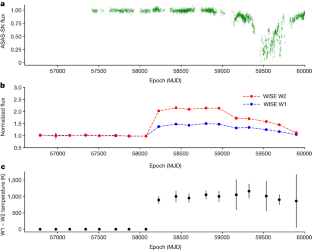2023-10-13 カーディフ大学
◆研究は、オールスカイ自動超新星調査(ASAS-SN)からの警告で始まり、星が予想外に暗くなったことを疑っていました。研究チームは、2つの氷の巨大惑星が衝突し、それに伴う赤外線の輝きがNEOWISE衛星によって検出されたと考えています。衝突から3年後、衝突の拡大した破片雲が星の前を通過し、星の可視光の明るさを薄くさせました。これにより、シネスティアの存在と星の薄くなるメカニズムが明らかになりました。
<関連情報>
- https://www.cardiff.ac.uk/news/view/2774450-planetary-collision-in-distant-solar-system-reveals-new-cosmic-object
- https://www.nature.com/articles/s41586-023-06573-9
惑星衝突の残光と破片雲のトランジット A planetary collision afterglow and transit of the resultant debris cloud
Matthew Kenworthy,Simon Lock,Grant Kennedy,Richelle van Capelleveen,Eric Mamajek,Ludmila Carone,Franz-Josef Hambsch,Joseph Masiero,Amy Mainzer,J. Davy Kirkpatrick,Edward Gomez,Zoë Leinhardt,Jingyao Dou,Pavan Tanna,Arttu Sainio,Hamish Barker,Stéphane Charbonnel,Olivier Garde,Pascal Le Dû,Lionel Mulato,Thomas Petit & Michael Rizzo Smith
Nature Published:11 October 2023
DOI:https://doi.org/10.1038/s41586-023-06573-9

Abstract
Planets grow in rotating disks of dust and gas around forming stars, some of which can subsequently collide in giant impacts after the gas component is removed from the disk1,2,3. Monitoring programmes with the warm Spitzer mission have recorded substantial and rapid changes in mid-infrared output for several stars, interpreted as variations in the surface area of warm, dusty material ejected by planetary-scale collisions and heated by the central star: for example, NGC 2354–ID8 (refs. 4,5), HD 166191 (ref. 6) and V488 Persei7. Here we report combined observations of the young (about 300 million years old), solar-like star ASASSN-21qj: an infrared brightening consistent with a blackbody temperature of 1,000 Kelvin and a luminosity that is 4 percent that of the star lasting for about 1,000 days, partially overlapping in time with a complex and deep, wavelength-dependent optical eclipse that lasted for about 500 days. The optical eclipse started 2.5 years after the infrared brightening, implying an orbital period of at least that duration. These observations are consistent with a collision between two exoplanets of several to tens of Earth masses at 2–16 astronomical units from the central star. Such an impact produces a hot, highly extended post-impact remnant with sufficient luminosity to explain the infrared observations. Transit of the impact debris, sheared by orbital motion into a long cloud, causes the subsequent complex eclipse of the host star.



